[ad_1]
If a tree falls in the woods, and no one hears it, did it actually happen?
More importantly, if your ad could have been shown to your audience but didn’t, wouldn’t you like to know about it?
Luckily, you can know how often your ads show (or don’t show) to your audience—thanks to a metric known as impression share. While it’s one thing to build out your Google Ads campaigns, it’s another to know they’re actually showing up as much as they could be. That’s where data sets like impression share, top impression rate, absolute top impression rate, and more can be a lifesaver.
However, since impressions don’t always equate to clicks or conversions, how important is impression share really to your overall account health? Plus, it’s no secret that Google Ads costs are rising across industries. Combine that with additional campaign insights and machine-learning capabilities more widely available for accounts, and you might feel like other metrics are taking priority when tracking your PPC progress.
As an advertiser, the last thing you need is to waste your time reporting on data that doesn’t directly impact your business’s bottom line. So, read on to find out if impression share is worth your time (or not) in 2023.
Table of contents
Quick review of Google Ads impression share
First, let’s walk through a refresher of what impression share actually means in terms of your account performance. Impression share is shown as a percentage and is designed to answer this key question: of all the times your ad could be showing, how often is it actually showing up?
Impression share metrics are only available for standard search, Shopping, and display campaigns.
Since the Google Ads auction is highly competitive, it’s nearly impossible for your ad to show every time someone searches for a keyword or browses a placement you’re bidding on. Impression share is there to help you understand how much market share your ads control.
While there are different types of impression share metrics that I’ll get into shortly, there are a few core terms to know when discussing impression share:
- Impression: When at least 50% of your ad is seen for at least one second.
- Impression share: Percentage of potential impressions your ad campaign wins the Google Ads auction for.
- Top impression rate: Percentage of how frequently your ad is above organic results (search campaigns only).
- Absolute top impression rate: Percentage of how frequently your ad is the first ad on the page (search campaigns only).
- Impression share lost to budget: Percentage of times your ad was not shown due to low budget, or in other words, your budget ran out too quickly or was not high enough to win the auction.
- Impression share lost to rank: Percentage of times your ad was not shown due to low ad rank, or in other words, your Quality Score wasn’t high enough to win the auction.
How do you calculate impression share?
Impression share is calculated based on the search volume for your PPC keywords. Google takes into account all the times you did show and divides it by all the times you could have shown. Luckily, the platform does the work for us when it comes to calculating impression share.
All you have to do is head to the campaign level of your account and add your impression share columns to see where your impression share and impression rates currently stand.
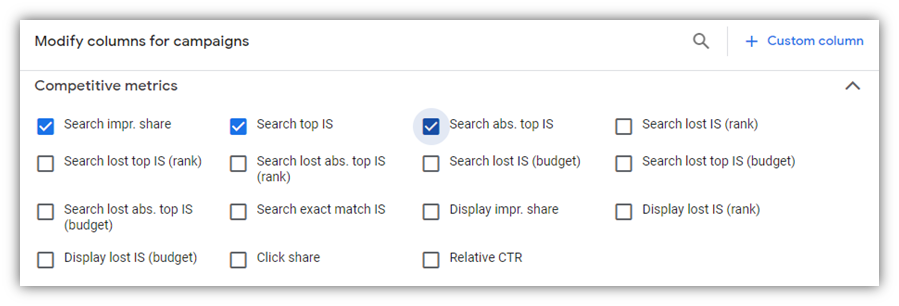
Types of impression share
Impression share means different things depending on your type of Google Ads campaign. Let’s review some notes for each of the campaign types that have impression share data available.
For Shopping campaigns, it’s important to know that any reported impression share metrics are only taking into account Google search placements and not Google Display Network (GDN) or partner Shopping placements.
Display campaigns only have “display impression share” metrics available. This makes sense as display ads don’t show on the SERP. Display impression share is the same concept as search impression share, but for placements across the GDN.
Finally, for any travel and tourism businesses, hotel campaigns also have impression share metrics available. However, they are calculated a bit differently which Google breaks down here.
For the purpose of this post, I’ll continue to evaluate the impact of impression share on standard search campaigns.
What is a good impression share?
Unfortunately, a common PPC pitfall is thinking that there’s a black-and-white answer to anything involving Google Ads! While I wish there was a clear answer to what the standard Google Ads benchmark for impression share should be, every account is unique. So, depending on your competition, you might find that a lower or higher impression share is feasible for your business.
At first glance, you might assume showing as much as possible to as many people as possible is the best impression share strategy. Instead, think of your impression share like a pool. Your targeting will determine how large or small your impression share pool is. The larger that pool, the more effort it will take to swim a full lap. You don’t want to have to swim all the way to the bottom to find that one search that will convert for you.
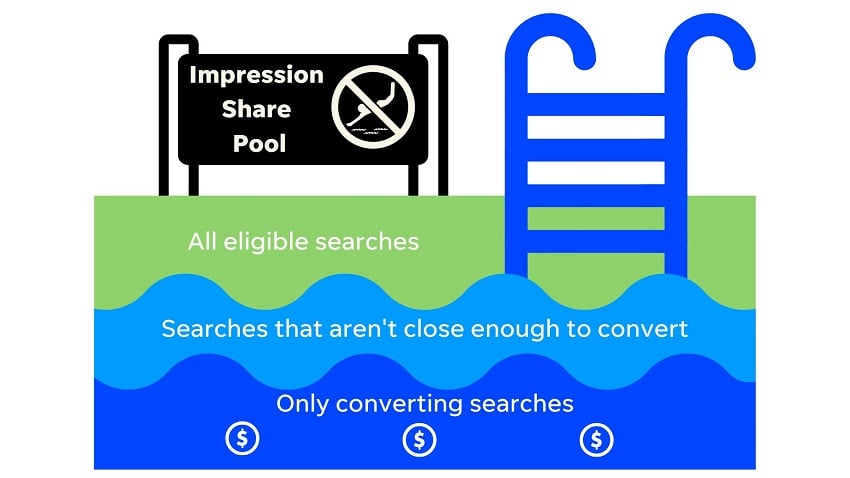
That said, you likely want to be showing more often than not. I’ve typically found that an impression share of 60-80% is ideal and realistic for most businesses. As for absolute top impression rate, or being the very first ad on the page, this metric can be a bit harder to achieve. However, a business with a healthy search campaign might find its absolute top impression rate to be around 20%.
Not sure where your account stands in terms of key metrics like impression share? Find out in seconds what optimizations you should prioritize with our free Google Ads Performance Grader.
Does impression share still matter in 2023?
With so many PPC metrics that take priority, how important is impression share at this point?
I might sound like a broken record, but like with everything in PPC, there’s sadly no clear yes or no answer to this question. How you value impression share will depend on your specific marketing goals and objectives.
That said, we recently saw at Google Marketing Live 2023 that the advertising landscape is rapidly changing with updates like the new Search Generative Experience as well as AI-generated assets for display (to name a few). Ad competition will only increase as more advertisers have the tools to create higher-quality ads. This means that, for advertisers leveraging standard search, shopping, or display campaigns, impression share is actually more important than ever before.
However, with so many different campaign options out there from Performance Max to Video and more, it’s a best practice to have a cross-channel approach to your Google Ads strategy—even if impression share data may not always be available for those other campaign types.
Benefits of a high impression share and impression rate
When you’re hitting all the goals you’re working towards with your Google Ads, like conversion rate or return on ad spend, you might not care as much about your impression share. However, impression share can make a big difference if you start to see your progress go awry.
For example, if you need to increase your click-through rate, improving your impression share can have a direct impact. In fact, ads that achieve a high absolute top impression rate can have a CTR of up to 5% higher than ads below them. Not only that, but cost per conversion can be up to 60% higher for advertisers that end up lower on the SERP.
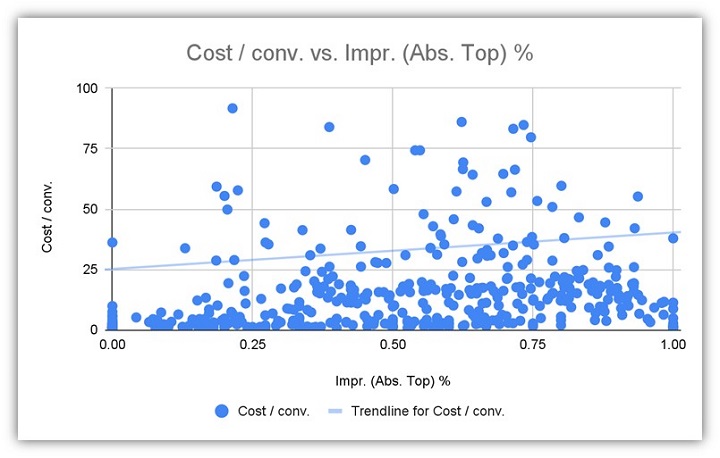
All in all, a high impression share means you’re showing more, which is the first step to getting someone to click on your ad. High top and absolute top impression rates mean you’re showing first (or second, or third, etc.), which can make all the difference in a highly competitive ad space, especially as that landscape continues to evolve.
Tips to improve your Google Ads impression share
If you feel like increasing your impression share aligns with your account’s goals, try out these Google Ads impression share tips:
1. Set your impression share goals
You’ll have to benchmark your current impression share metrics in order to track your progress. If you’re not sure what impression share is realistic to shoot for, you won’t know where to start when it comes to implementing the right impression share strategy.
First, take note of all your current impression share metrics across your account. Next, evaluate your campaign budgets to see if reaching a higher impression share percentage is feasible or not.
Lastly, for standard search and Shopping campaigns, advertisers may also want to look at the Auction Insights report when setting impression share goals. Since Auction Insights show how you rank against competitors on the SERP, this report can help inspire your impression share goals.
Looking at Auction Insights, your budget, and your current impression share and impression rates will help you get a better understanding of what’s realistic for your business.
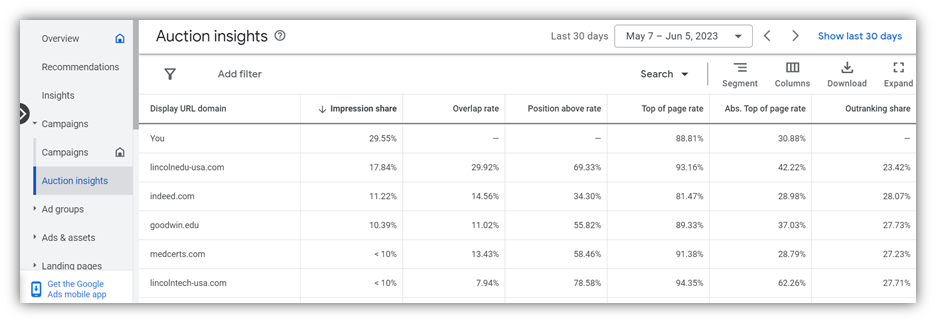
2. Location, location, location
How do you make a higher impression share easier to achieve? You make your impression share pool smaller! A smaller location makes a higher impression share more feasible since you’ll have fewer eligible users to show to depending on their physical location. This can be a great way for a local business to narrow in on audience members nearby with a higher likelihood of converting.
3. Refine your keyword list
Another way to tighten up your targeting so that you can increase youre impression share is to refine your keywords to only high-intent core terms. Search intent is critical when you’re optimizing for a specific metric like impression share since you’ll only want your ad to show when it matters most.
When you focus on keywords with transactional intent rather than informational, you’re narrowing your eligible impressions down to users who are further along in the buyer’s journey.
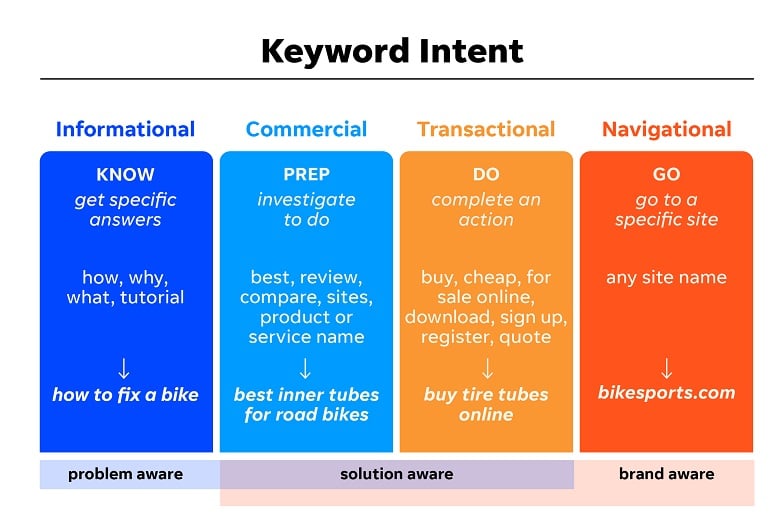
4. Diversify your campaign types
This Google Ads impression share tip should not come as a surprise considering the rise in popularity of campaign types beyond the typical standard search or display campaigns. When you’re considering your impression share, you’ll want to look at your account holistically. Try to incorporate a variety of campaign types to fill in the gaps your impression share rates can’t.
Leveraging multiple different strategies, like video, Local Services Ads, and more, will help increase your business’s overall performance on Google Ads. Plus, multiple different campaign types ensure you’re maximizing your impression potential across all touchpoints in your customer’s journey.
5. Elevate your ad copy
While you do want to try a few different campaign types to maximize your impression share overall, you should also still focus on ad quality over quantity. A strong ad will show higher up on the SERP–increasing your top and absolute top impression rates as well as overall impression share. (Not to mention, it can help increase conversion rates, too!)
First, look at your ad copy to see if you’re meeting the basics like including keywords, power words, calls to action, and more. Additionally, you may want to leverage more ad assets (formerly known as ad extensions), like images, structured snippets, and so on, to help your ad take up more SERP real estate.
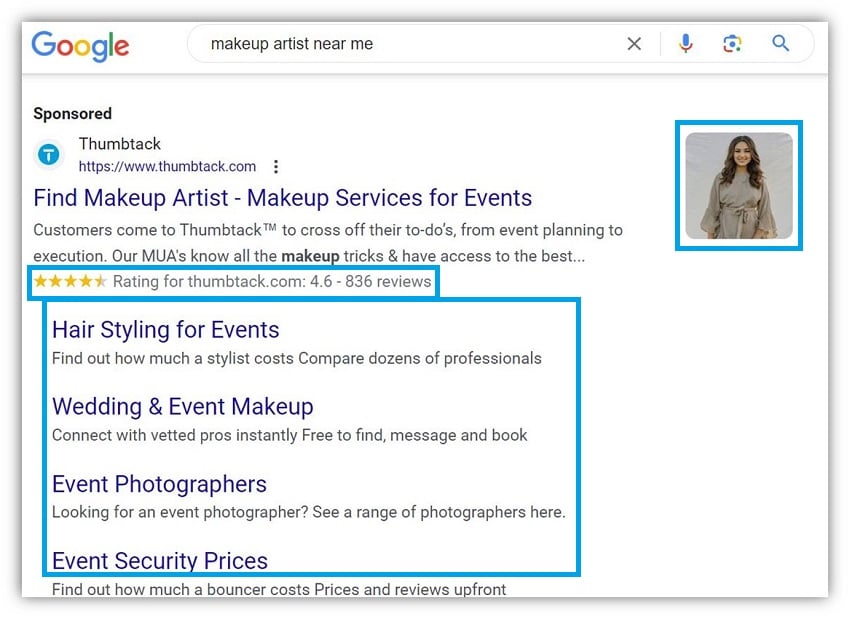
This example of a high-quality ad includes powerful, keyword-rich copy. It also uses ad assets like images and sitelinks.
Grow your impression share, grow your business
While the importance of impression share in 2023 and beyond is dependent on your specific account, use this article as a reminder to check in on metrics you may not be tracking regularly.
Impression share is just one of many metrics that can often be disregarded in favor of “money metrics” like cost per lead or conversion rate. However, your impression share can have a “snowball effect” on your account if it’s not tended to properly. So, use our tips here to help grow your impression share, and ultimately, grow your business!
Here are those tips to improve your impression share:
- Set impression share goals
- Narrow your location targeting
- Refine your keyword list
- Diversify your campaign types
- Elevate your ad copy
[ad_2]
Source link









